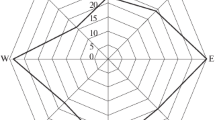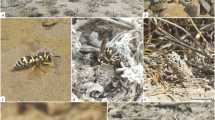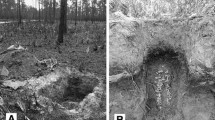Summary
Camponotus detritus nests are simple structures excavated among the roots of perennial vegetation in the sand dunes of the Namib Desert. They comprise a series of tunnels and chambers 100–400 mm deep, often lined with detritus. No “royal chamber” or food stores were found. Brood was found throughout the nest, throughout the year. Nest temperatures varied considerably. Mean nest temperatures were about 32°C in summer and 20–23°C in winter. The number of workers per nest varied from 218 to 16,000 with a mean and standard error of 3,404±570. Each colony comprised one to four nests. Only one nest per colony housed queens. Colony expansion and nest relocation occurred frequently.
Resume
Les nids deCamponotus detritus sont des structures simples, creusées parmi les racines de la végétation pérenne des dunes du désert de Namibie. Ils comprennent une série de tunnels et de chambres de 100–400 mm de profondeur, souvent tapissés avec des détritus. On ne trouve pas de «chambre royale» ou de réserves de nourriture. Le couvain se trouvait d'un bout à l'autre du nid. Les températures des nids variaient considérablement. Les températures moyennes des nids étaient d'environ 32°C en été et 20–23°C en hiver. Le nombre d'ouvrières par nid variait de 218 à 16 000 avec une moyenne de 3 404±570. Chaque colonie comprenait un à quatre nids. Seulement un nid par colonie avait des reines. Le développement des colonies et le changement de localisation des nids avaient lieu fréquemment.
Similar content being viewed by others
References
Curtis B.A., 1983. — Behavioural and physiological ecology of the Namib Desert dune ant,Camponotus detritus Emery. Unpubl. M. S.thesis, University of Cape Town, South Africa.
Curtis B.A., 1985. — The dietary spectrum of the Namib Desert dune ant,Camponotus detritus Emery.Insect. Soc., 32, 78–85.
Délye G., 1968. — Recherches sur l'écologie, la physiologie et l'éthologie des fourmis du Sahara. Unpubl. Ph. D.thesis, University of Aix-Marseille, France.
Lévieux J., 1975. — La nutrition des fourmis tropicales. I. Cycle d'activité et régimes alimentaires deCamponotus solon (Forel) (Hymenoptera, Formicidae).Insect. Soc. 22, 381–390.
Mabelis A.A., 1979. — Wood ant wars. The relationship between aggression and predation in the red wood ant (Formica polyctena Forst).Neth. J. Zool., 29, 451–620.
Möglich M., Hölldobler B., 1974. — social carrying behaviour and division of labour during nest moving in ants.Psyche, 81, 219–236.
Murray G.W., 1981. — The food of the Namib wedge-snouted sand lizard,Meroles cuneirostris (Strauch) (Lacertidae) and comparison with that of the Namib sanddiving lizardAporosaura anchietae (Bocage) (Lacertidae). Unpubl. B. Sc. (Hons) thesis, University of the Witwatersrand, Johannesburg, South Africa.
Pricer J.L., 1908. — The life history of the carpenter ant.Biol. Bull., 14, 177–218.
Sanders C.J., 1970. — The distribution of carpenter ant colonies in the spruce-fir forests of northwestern Ontario.Ecology, 51, 865–873.
Seely M.K., Stuart P., 1976. — Namib climate: 2. The climate of Gobabeb, ten-year summary 1962/72.Namib Bulletin 1.
Skaife S.H., 1961. — The study of Ants. Longmans, Cape Town. 178 p.
Sokal R.R., Rohlf F.J., 1981. — Biometry. Second Edition. Freeman and Co, San Fransisco.
Wheeler W.M., 1910. —Ants: Their structure, Development and Behaviour. Columbia University Press, New York, 663 p.
Wilson E.O., 1959. — Some ecological characteristics of ants in New Guinea rainforests.Ecology, 40, 437–447.
Wilson E.O., 1971. —The Insect Societies. Belknap Press of Harvard University Press, Cambridge, Massachusetts, 548 p.
Author information
Authors and Affiliations
Rights and permissions
About this article
Cite this article
Curtis, B.A. Nests of the namib desert dune antCamponotus detritus Emery. Ins. Soc 32, 313–320 (1985). https://doi.org/10.1007/BF02224920
Received:
Accepted:
Published:
Issue Date:
DOI: https://doi.org/10.1007/BF02224920




